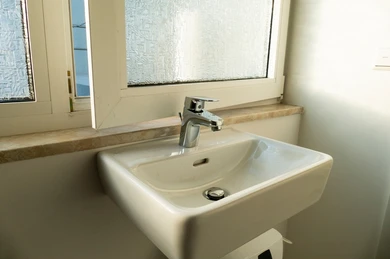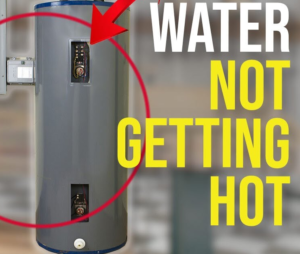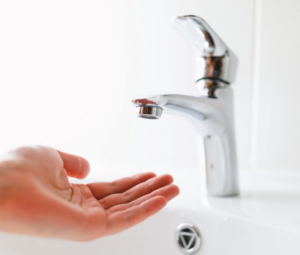A clogged sink is one of the most common household plumbing issues. Whether it’s in the kitchen or bathroom, a sink that won’t drain can quickly become a frustrating problem. Not only does it prevent you from using your sink, but it can also lead to bad odors, unsanitary conditions, and, in some cases, water damage. The good news is that you can often fix a clogged sink yourself with a few simple tools and techniques. In this article, we’ll walk you through what to do when your sink won’t drain, from easy at-home remedies to when you might need to call a professional plumber.
1. Understanding Why Your Sink Won’t Drain
Before diving into solutions, it’s helpful to understand why sinks get clogged in the first place. Kitchen sinks often get blocked by food particles, grease, oil, or soap scum that builds up over time. Bathroom sinks, on the other hand, are typically clogged by hair, soap, toothpaste, and grooming products.
Common reasons for a clogged sink include:
- Food particles (in kitchen sinks)
- Grease and oil buildup
- Hair (in bathroom sinks)
- Soap scum accumulation
- Foreign objects accidentally dropped down the drain
Knowing what might be causing the clog can help you choose the right solution.
2. First Step: Check for Visible Blockages
The first thing to do when your sink won’t drain is to check for any visible blockages. If you see food scraps, hair, or debris near the drain, remove it. You can often use your fingers, a pair of tweezers, or a bent wire hanger to pull out clumps of hair or gunk.
Here’s how to do it:
- Put on gloves to protect your hands from dirt and bacteria.
- Remove the drain cover (if applicable) and inspect the drain for any obvious obstructions.
- Use tweezers or a bent wire hanger to reach down the drain and pull out any visible debris.
- Rinse with warm water to see if the blockage is gone.
If this doesn’t solve the problem, it’s time to move on to more advanced methods.
3. Try Boiling Water
One of the simplest ways to clear a clogged sink is by using boiling water. This method is especially effective for grease or soap buildup in kitchen sinks, as the heat can dissolve the substances causing the clog.
Instructions:
- Boil a large pot of water on the stove.
- Carefully pour the boiling water directly into the sink drain.
- Wait a few minutes to see if the water drains. You may need to repeat this process two or three times for stubborn clogs.
While boiling water can work wonders for mild blockages, it may not be effective against more significant clogs caused by hair or large debris.
4. Use a Plunger
A plunger can be a lifesaver when it comes to unclogging a sink. It works by creating pressure that can help dislodge whatever is blocking the drain. You’ll want to use a cup-style plunger specifically for sinks (rather than a toilet plunger).
How to plunge a sink:
- Remove the stopper from the sink (if necessary).
- Fill the sink with a few inches of water to help create a seal.
- Place the plunger over the drain, ensuring a tight seal around the edge.
- Push down and pull up quickly to create suction and pressure. Do this for about 20-30 seconds.
- Check if the water drains once you’re done plunging.
If the water starts draining, your clog may be cleared. If not, try plunging again or move on to other solutions.
5. Use a Baking Soda and Vinegar Solution
If plunging doesn’t work, a natural solution using baking soda and vinegar can often help break down clogs. This method is especially effective for clogs caused by soap scum or grease.
Here’s how to do it:
- Remove as much water from the sink as possible.
- Pour 1 cup of baking soda down the drain, making sure it reaches the clog.
- Follow with 1 cup of vinegar (white or apple cider vinegar works well).
- Cover the drain with a plug or cloth to contain the reaction.
- Let the mixture sit for 15-20 minutes. During this time, the baking soda and vinegar will create a fizzy reaction that helps break down the clog.
- Flush with boiling water to clear the drain.
Repeat the process if necessary. This is a chemical-free method that’s safer for your pipes and the environment than harsh chemical drain cleaners.
6. Clean the P-Trap
If your sink still won’t drain after trying the methods above, the problem could be in the P-trap (the U-shaped pipe under your sink). This part of the plumbing is designed to trap debris and prevent sewer gases from entering your home, but it can also get clogged.
Steps to clean the P-trap:
- Place a bucket under the P-trap to catch any water or debris.
- Use a wrench or pliers to loosen the nuts on either side of the P-trap.
- Remove the P-trap and clean out any debris inside. You can use an old toothbrush or pipe cleaner to scrub it out.
- Rinse the P-trap with water and reattach it to the sink.
- Test the sink to see if the water drains properly.
If cleaning the P-trap doesn’t resolve the issue, the clog may be further down the pipe, requiring more intensive methods.
7. Use a Drain Snake
A drain snake, or plumber’s snake, is a handy tool designed to reach clogs deep within your plumbing system. It’s a long, flexible wire that you feed down the drain to break up or retrieve the blockage.
How to use a drain snake:
- Insert the snake into the drain and begin feeding it down the pipe.
- When you feel resistance, turn the handle to grab or break up the clog.
- Pull the snake out and remove any debris attached to it.
- Flush the drain with water to ensure the blockage is cleared.
Drain snakes can be purchased at most hardware stores, or you can rent one if it’s a one-time use.
8. Avoid Chemical Drain Cleaners
You may be tempted to reach for a chemical drain cleaner, but these can be harmful to your pipes, especially if they’re old or made of certain materials. Chemical cleaners can also be dangerous to your health if mishandled. Additionally, they often only provide a temporary fix and don’t always resolve the root cause of the clog.
If you decide to use a chemical cleaner, follow the instructions carefully and use it as a last resort.
9. Call a Professional Plumber
If none of these DIY methods work, it’s time to call in a professional plumber. Persistent clogs, especially those that don’t respond to plunging, snaking, or cleaning the P-trap, could indicate a deeper issue in your plumbing system, such as tree roots or a damaged pipe.
A plumber can diagnose the problem and use professional tools like hydro-jetting or video camera inspections to fix the issue. While this can be more costly than DIY methods, it’s often necessary to prevent further damage to your plumbing.
10. Prevent Future Clogs
Once you’ve successfully unclogged your sink, it’s important to take steps to prevent future blockages. Here are some tips to keep your drains flowing smoothly:
- Use a drain strainer to catch food particles, hair, and other debris.
- Dispose of grease and oil properly by letting them cool and solidify before throwing them in the trash.
- Avoid putting coffee grounds, eggshells, or fibrous foods (like celery) down the kitchen drain.
- Regularly flush your drains with boiling water to break down any potential buildup.
Conclusion
When your sink won’t drain, it can be a stressful and inconvenient problem. Fortunately, with the right tools and techniques, most clogs can be fixed at home. Whether you’re plunging, using a baking soda and vinegar solution, or snaking the drain, these steps will help you get your sink back in working order. If DIY methods don’t work, don’t hesitate to call a professional plumber to tackle the problem at its source.
FAQ
Why is my sink not draining?
Common reasons include a clogged drain, buildup of food particles, grease, soap scum, or hair. It could also be due to a blocked pipe or a more serious plumbing issue.
2. How can I unclog a sink that won’t drain?
You can try using a plunger, a drain snake, or a mixture of baking soda and vinegar to dissolve minor clogs. For tougher clogs, a chemical drain cleaner or calling a professional may be necessary.
3. Is it safe to use chemical drain cleaners to fix a clogged sink?
Chemical drain cleaners can be effective but should be used with caution. Overuse can damage pipes, especially if you have older plumbing. Always follow the instructions and consider safer alternatives like natural cleaners or mechanical methods.
4. What are some natural ways to unclog a sink?
You can try using a mixture of baking soda and vinegar followed by boiling water. Another option is a salt and hot water flush, which can break down minor blockages.
5. Should I call a plumber if my sink won’t drain?
If DIY methods fail to clear the clog or if you notice unusual smells, gurgling sounds, or slow draining throughout your home, it’s best to call a plumber to avoid more serious issues.
6. Can a plunger work on a sink that won’t drain?
Yes, a plunger can help remove clogs in the sink by creating suction to dislodge trapped debris. Make sure to cover any overflow holes to create a better seal when plunging.
7. What should I avoid putting down the sink to prevent clogs?
Avoid putting grease, oil, coffee grounds, food scraps, and hair down the sink. Use a drain cover to catch debris and minimize the risk of clogging.
8. What is a P-trap, and can it cause my sink to clog?
A P-trap is the curved pipe under the sink that traps debris and prevents sewer gases from entering your home. Over time, it can accumulate debris and cause blockages. Cleaning the P-trap may resolve drainage issues.
9. How can I prevent my sink from getting clogged in the future?
Regularly clean your sink, avoid pouring grease or food particles down the drain, and use a drain cover to catch debris. Flushing your sink with hot water and natural cleaners periodically can also help prevent clogs.
10. Can tree roots or external factors cause my sink not to drain?
Yes, in some cases, tree roots can infiltrate your plumbing system, leading to blocked drains. If you suspect this, a plumber can inspect your pipes using specialized equipment to diagnose the issue.





